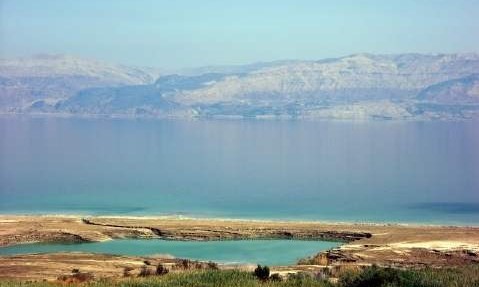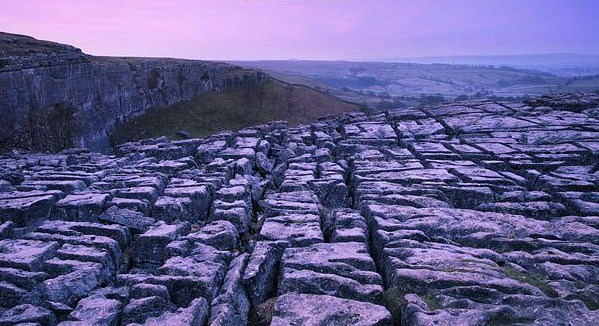What is Limestone?
Limestone is an organic, sedimentary rock. This means it was formed from the remains of tiny shells and micro-skeletons deposited on the sea bed. Limestone often contains variable amounts of silica in the form of chert and/or flint, as well as varying amounts of clay, silt and sand as disseminations, nodules, or layers within the rock. The primary source of the calcite in limestone is most commonly marine organisms. They were compressed to form solid rock. Limestone is made up of calcium carbonate and reacts with diluted hydrochloric acid. Limestone is formed in layers - called bedding planes. These bedding planes contain vertical cracks called joints. Joints and bedding planes make the rock permeable.
Erosion of Limestone
Weathering is the breakdown of rock by physical, chemical or biological processes. Limestone areas are weathered when rainwater, which contains a weak carbonic acid, reacts with limestone. When it rains limestone is dissolved. Rainwater erodes the joints and bedding planes. In doing this Karst scenery is created. Limestone is less resistant than most igneous rocks, but more resistant than most other sedimentary rocks. Limestone and marble are very reactive to acid solutions, making acid rain a significant problem. Many limestone statues and building surfaces have suffered severe damage due to acid rain. Acid-based cleaning chemicals can also etch limestone, which should only be cleaned with a neutral or mild alkaline-based cleaner. Click here to see care shop Lithofin easy care cleaner.
Limestone (Karst) Features - above ground
Karst scenery includes:
Swallow hole - An exposed limestone joint down which a surface river 'disappears'. see picture below

Clints and grykes - Rainwater flowing over an impermeable surface will, on reaching permeable surface as limestone, be able to dissolve the joints into grooves called grykes, leaving blocks or clumps of limestone in between called clints.
Limestone pavements - Exposed clints and grykes. The picture below shows a limestone pavement at Malham, Yorkshire Dales.

Limestone (Karst) Features - below ground
Stalactite is made by water dripping from the roofs of caves leave behind microscopic particles of calcium carbonate. These build up as icicle shaped stalactites.
Stalagmite is made by drips splashing onto the cave floor create stalagmites.
Limestone and Recreation
Limestone areas offer a wide range of opportunities to recreationists. This includes - pot holing, caving, walking, climbing, abseiling and many other outdoor pursuits.
Uses of limestone
Limestone has many uses:
- In the home as flooring tiles, tables, fireplaces and vanities
- to make glass
- In the production of paper and iron
- as a building material
- to make cement and to neutralise acidic soils and lakes
Home
Limestone is quarried in blocks to make slabs and calibrated into tiles to make beautiful floor tiles, bespoke fireplaces, tables, tops and vanities
Glass
Glass is made by heating a mixture of sand, limestone and soda (sodium carbonate) until it melts.
When the mixture cools it comes out as glass.
Glass is used for many everyday things such as windows, glasses and mirrors.
Paper
Paper is made of wood pulp.To make this, acid is used to break the wood down.
Limewater is used to neutralise the acid, and also helps to whiten the paper.
It is also used as a bulking agent, so less trees are cut down to make the paper.
Iron
When iron is made in the blast furnace, the impurities in the iron must removed.
Limestone mixes with the impurities in the iron in the blast furnace, and forms a substance known as slag. The slag is separated from the iron, and taken away, leaving pure molten iron which can be made into steel.
Building Material
Limestone has been used for building for many centuries.
Many old buildings are made out of limestone.
However, it can be gradually dissolved by acid rain.
.jpg)
Made of Limestone The Great Pyramids of Giza
Neutralisation
Ordinary limestone, ground into a powder, can be used to neutralise acidity in lakes and soils caused by acid rain.
The calcium carbonate is a base (an insoluble alkali), and so can neutralise the acid.
Slaked lime works in the same way but is much faster.
Cement
When limestone is heated with clay it forms cement, a substance that sets gradually when it reacts with water.
Cement can be made into mortar by adding sand and water. Mortar is used to set the bricks in walls, as when it dries it acts as an adhesive between the bricks.
Cement can also be made into concrete by adding water, sand and small stones or gravel.
Concrete is used for all kinds of building work, including paths, walls and large buildings.
So for your Limestone tile cleaning, care or maintenance in Manchester please call Absolute Tile Care 07962 532526.
- Tile Cleaning
- Commercial Projects
- Marble Care
- Ask the Expert
- Contact Us
- Gallery Other
- How is marble formed
- The 7 secrets of Granite
- The 7 secrets of Tiles
- Customer Questions and Answers
- Granite/Quartz kitchen worktops
- Floor Care and Restoration
- Lithofin Shop
- Feedback
- LTP Care products
- Chip Repair In Manchester
- Privacy policy


